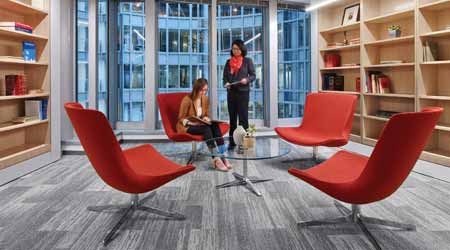 Providing a variety of enclosed spaces within an office can decrease acoustical disruption. At the American Insurance Association in Washington, D.C., the library was enclosed and absorptive materials used to mitigate noise and associated effects.© Eric Laignel, courtesy CallisonRTK
Providing a variety of enclosed spaces within an office can decrease acoustical disruption. At the American Insurance Association in Washington, D.C., the library was enclosed and absorptive materials used to mitigate noise and associated effects.© Eric Laignel, courtesy CallisonRTKBig-Impact Health and Wellness Strategies
Focusing on ergonomics, biophilia, stress management, privacy, and sustainability all have huge benefits. And these health and wellness strategies promote good work/life balance as well.
It can be easy to talk about well-being without pointing to specific examples, but as wellness and well-being become more integral parts of the workplace conversation, there are plenty of approachable implementation strategies and examples of human-centered design and operations.
Specifying ergonomic furnishings increases movement, supports cognition and productivity, increases engagement, and cuts down on work-related health complaints. There’s evidence that a lack of training can cause users to avoid ergonomic products altogether, decreasing the potential for furniture and equipment to support physical well-being, so education and guidance are crucial.
Incorporating natural elements (plants, natural imagery, organic forms, plant-based materials) supports cognition and productivity, promotes alertness and mood, promotes restoration, and decreases risks associated with workplace stress. Biophilia is a popular workplace buzzword, but its popularity is partially rooted in research: As humans, we’re wired to respond positively to nature, so natural elements in an interior environment can have positive effects.
Understanding organizational management of stress/mental health supports stress management, promotes flexibility, and decreases the risk of burnout. While more of a cultural than an architectural consideration, mental health management is a crucial component of the way employees think, feel, and act while at work, and represents an opportunity to ease stress and promote peace of mind for everyone.
In the open office, privacy is often the name of the game, but while our coworkers sometimes represent distractions, they’re also an important component of well-being. Social interaction is a vital part of human nature and promoting interaction in the workplace can promote company culture and idea-sharing while also providing an opportunity to break away from work tasks.
While it’s never possible to please everyone, considering stakeholder opinions in the design process can allow for a design that is truly human-centered. Seeking employee input is a great way to make sure the environment appropriately addresses challenges, and understanding employee priorities can help in identifying areas for improvement. This can have positive impacts on engagement and company culture.
From a design and fit-out standpoint, selecting and specifying sustainable materials can have a big impact. Beyond just the way something looks or feels, recyclable or sustainable content contributes to organizational waste reduction and reduced emissions of substances like volatile organic compounds. Selecting healthy materials reduces emissions of chemicals into the air, contributing to cleaner indoor air for breathing.
Supporting work/life balance
Creating a supportive and people-centric office is the best way to promote work-life balance. Understanding employee priorities and concerns can help identify opportunities to benefit occupants through design and operations. Understanding the employee experience can help with identifying target areas, from look and feel, to architectural elements (lighting, air quality, materials selection) and amenities, to perks (food and drink, fitness, transportation). Thinking through the employee experience allows for a more holistic approach, providing the opportunity to pursue solutions that positively impact occupants. Understanding utilization patterns and user interaction with the environment can also help maximize square footage and contribute to spaces that are well-utilized.
Even the world’s coolest workplace won’t support employee satisfaction without a supportive company culture. Organizations must develop an operational approach to support the physical workplace. Wherever possible, providing adjustability, choice, and control supports interaction with the built environment, and providing a variety of spaces to fit different workstyles and preferences can increase space utilization. Culturally, the organization must also manage expectations around space utilization in the office, as well as practices around connectivity, remote work, and off-hours work. Supporting work-life balance goes beyond the workplace itself and supporting employee wellness involves consideration of cultural as well as architectural elements.
The heart of the issue for designers is that people interact with their environments in many different ways. Systems like WELL, although not a panacea, provide a good foundation for understanding key areas for impacting employee well-being. As organizations develop their own approaches to employee wellness, both employees and organizations will benefit.
Joelle Jach (joelle.jach@crtkl.com), WELL AP, LEED Green Associate, Assoc. IIDA, is a workplace strategist in
CallisonRTKL’s Dallas office.
Related Topics:















